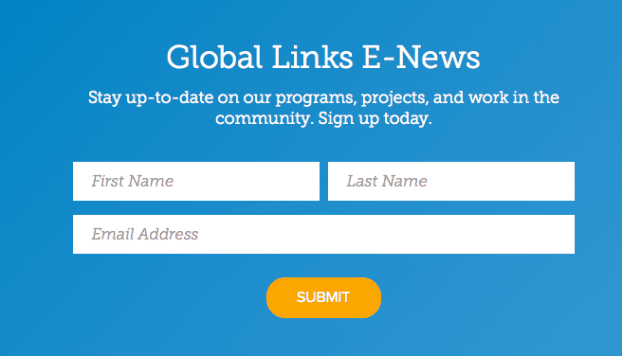5 Easy Ways To Grow Your Nonprofit Email List

It’s hard for some people to use the words “nonprofit” and “marketing” in the same sentence. For one reason or another, they don’t feel comfortable with the idea of marketing an organization that’s built to give back.
However, nonprofits need a marketing plan just as much as (if not more than) for-profit companies. This allows them to connect with past donors, potential donors, and the media, among others.
When it comes to online fundraising, email accounted for 26 percent of all online revenue in 2017 (a 15-percent growth over the previous year). While your marketing plan may (and should) entail other strategies, there’s a good chance email will drive a big part of what you do. With this in mind, it’s critical to devote the necessary resources toward growing your email list.
Here are five things you can do today to grow your email list:
1. Use Social Media
You’ve taken the time to build a strong social media presence. You share valuable content, you engage with your audience, and you do a good job pushing people to your website.
Now, it’s time to use social media to grow your email list. There are two ways you can do this:
Periodically post a reminder to sign up for your email list
Post content that takes your audience to your website and prompt them to sign up for your list
The first option is direct; there’s no beating around the bush here. The benefit is that some people will immediately sign up for your email list. The potential drawback is that others may consider this spam, thus chasing them away.
As long as you’re careful about how often you ask people to sign up and the manner in which you do so, the number of people you aggravate should be minimal (if there are any at all).
2. Update Your Website With CTAs
Your website should be the engine that runs your email marketing growth strategy. Even if social media is “your thing,” your website is where many people make the final decision about whether or not to subscribe to your email list.
Here’s the problem: Many nonprofits make the mistake of assuming that their audience will find their sign-up form and provide all the information they’re asked for on their own. This is an assumption you can’t afford to make. Instead, you want to make their job as easy as possible by including calls to action (CTA).
Global Links is a great example of a nonprofit that does it the right way with their CTAs. Here’s what you see on the homepage, as well as several other key placements on the website:

Some of the things you can do to grow your list include:
Placing your sign-up form on high-traffic pages
Limiting the amount of information you ask for (name and email address is fine)
Letting people know what they’re signing up for (see above)
If you’re not making the most of your website, you’re missing out on a big opportunity.
3. Collect Email Addresses At Your Events
Most nonprofits hold events throughout the year. For example, check out the Nonprofit Association of Oregon calendar of events. A quick glance shows you that there’s at least one event almost every day of the week.
There’s a lot that goes into planning and managing a successful event, but that’s no excuse to miss out on this opportunity to collect email addresses.
There are a couple of simple ways to do so:
Ask attendees to provide their email address upon checking in (or when they sign up)
Use an event check-in app that allows you to collect email addresses
It doesn’t matter if you have a traditional check-in process with your team doing all the work or you rely on an app as long as you have the opportunity to collect an email address for every person who comes through the door.
It’s easy to get so caught up with your online strategy that you overlook the true power of face-to-face events, but you won’t want to miss out on this opportunity.
4. Send An Email After Receiving A Donation
This is one of those little tricks that many nonprofits forget about, especially those that haven’t thought too much about email marketing.
One of your primary goals as a nonprofit is to obtain donations. You go about doing this in many ways, and it’s likely that a large portion of your donations come through your website.
But here’s the thing: Just because someone donates doesn’t necessarily mean you can add them to your email list.
You need to do one of two things:
Give donors the option to sign up for your email list at the time of making a donation
Send a personalized email after receiving the donation to say thanks and ask the person to opt in to your email newsletter
It’s good marketing practice to give the option to sign up at the time of donation, making the default selection “yes.” For those who don’t opt-in at that time, you can then share more information in your thank you email.
5. Share Valuable Content
Sharing valuable content is one of the best ways to engage your audience and give them one more reason to sign up for your email list.
A great example of this is The Pittsburgh Foundation, as they feature a variety of content on their homepage, including news releases, stories, and more.
If you can, create and share valuable content on your website, via social media, and through traditional methods such as postcards and letters. For a push in the right direction, include a CTA for your newsletter at the bottom of each piece of content on your website.
Conclusion
With an average open rate of 24 percent, nonprofit organizations are in prime position to take full advantage of email marketing. All it takes is time, creativity, and a growing email list.
Schedule a live demo with our partner Bloomerang, and we’ll show you how easy it is to create and automate reports, utilize online and offline fundraising tools, quickly integrate and access all your data, and ultimately create more time to engage your donors.